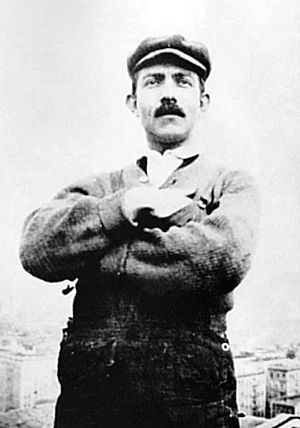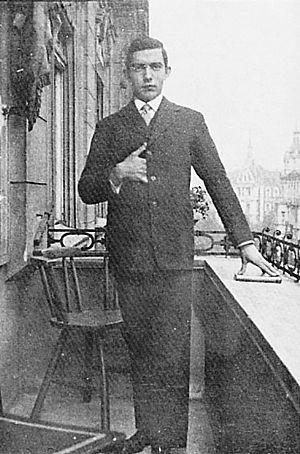Wallingford Riegger facts for kids
Quick facts for kids
Wallingford Riegger
|
|
|---|---|

Riegger in New York City, c. 1930s
|
|
| Born | April 29, 1885 Albany, Georgia, U.S.
|
| Died | February 4, 1961 (aged 75) |
| Occupation | |
| Spouse(s) |
Rose Schramm
(m. 1911) |
| Children | 3 |
Wallingford Constantine Riegger (US: /ˈriɡər/ REE-gur; April 29, 1885 – April 2, 1961) was an American composer and pianist. He was famous for his orchestral music and pieces for modern dance. Riegger was born in Albany, Georgia, but spent most of his life in New York City. He helped other American composers like Charles Ives and Henry Cowell become more recognized. Riegger was also one of the first American composers to use a special music technique called serialism or the twelve-tone technique.
Contents
About His Life
Wallingford Riegger was born in 1885. His family moved a few times when he was young. They finally settled in New York in 1900. He was very good at playing the cello.
Early Music Training
Riegger was part of the first group to graduate from the Institute of Musical Art in 1907. This school is now known as the Juilliard School. He then studied music in Berlin, Germany, for three years.
After returning to America in 1910, he married Rose Schramm in 1911. They had three daughters together. He went back to Germany to work as a conductor. But when the United States joined World War I in 1917, he moved back home.
Teaching and Later Life
From 1918 to 1922, Riegger taught music theory and cello at Drake University. For many years, from 1930 to 1956, he kept composing and teaching. He taught at different colleges in New York, including the Institute of Musical Art and Ithaca College.
In 1957, he was asked to appear before a government committee. This committee was looking into certain political ideas in the music world. In 1958, the famous conductor Leonard Bernstein honored Riegger. Bernstein conducted Riegger's Music for Orchestra with the New York Philharmonic Orchestra.
Wallingford Riegger died in New York in 1961. He had an accident where he tripped over two dogs and hit his head. Leonard Bernstein said in his speech about Riegger, "All who knew Wally loved him."
Some of his students included Robert Ashley, Louise Spizizen, Alan Stout and Merton Brown. See: List of music students by teacher: R to S#Wallingford Riegger.
His Music Style
Riegger was known for using a special music system called the twelve-tone system. This was similar to the ideas of composer Arnold Schoenberg. Riegger learned about this technique from Schoenberg's student, Adolph Weiss. However, Riegger did not use this system in all his music. He also used it in his own way. For example, he did not always use twelve notes in a row.
Besides Schoenberg, Riegger was also greatly influenced by his friends Henry Cowell and Charles Ives.
Early Compositions
When Riegger first started composing, his music sounded different from his later work. His early pieces were more like romantic music.
Later Compositions
In the mid-1930s, Riegger began writing music for contemporary dance. As his career went on, he started using Schoenberg's twelve-tone technique more often. But he would sometimes go back to his older styles. From 1941, he mostly focused on music for instruments. His Symphony No. 3 won the New York Music Critics' Circle Award. It also received a Naumburg Foundation Recording Award.
Selected Works
Here are some of Wallingford Riegger's musical pieces:
- Orchestral
- Fantasy and Fugue, Op. 10 (1930)
- Dichotomy, Op. 12 (1931)
- Consummation, Op. 31 (1939)
- Passacaglia and Fugue, Op. 34a (1942)
- Symphony No. 1 (1944)
- Symphony No. 2 (1945)
- Symphony No. 3, Op. 42 (1946–1947, revised 1960)
- Music for Orchestra, Op. 50 (1958)
- Suite for Younger Orchestras, Op. 56 (1953)
- Romanza for string orchestra, Op. 56a (1953); Lullaby from the Suite for Younger Orchestras
- Dance Rhythms, Op. 58 (1954)
- Overture, Op. 60 (1955)
- Preamble and Fugue, Op. 61 (1955)
- Symphony No. 4, Op. 63 (1956)
- Festival Overture, Op. 68 (1957)
- Quintuple Jazz, Op. 72 (1958)
- Sinfonietta, Op. 73 (1959)
- Canon and Fugue for string orchestra
- Concert band and wind ensemble
- Ballet for Band, Op. 18 (1935)
- Passacaglia and Fugue, Op. 34 (1942)
- Processional, Op. 36 (1943)
- Music for Brass Choir, Op. 45 (1949)
- Prelude and Fugue, Op. 52 (1953)
- Dance Rhythms, Op. 58a (1954); original for orchestra
- Concertante (music for a solo instrument with orchestra)
- Elegy for cello and orchestra (1916)
- Concerto for piano with wind quintet, Op. 53 (1953)
- Variations for piano and orchestra, Op. 54 (1952–1953)
- Variations for violin and orchestra, Op. 71 (1959)
- Introduction and Fugue for cello and concert band, Op. 74 (1960)
- Chamber music (music for a small group of instruments)
- Elegy for viola and piano (1915)
- Piano Trio in B minor, Op. 1 (1919)
- Revery for cello (or viola) and piano (1920)
- Lullaby for cello (or viola) and piano (1922)
- Study in Sonority for 10 violins or any multiple thereof, Op. 7 (1927)
- Suite for flute solo, Op. 8 (1929)
- String Quartet No. 1, Op. 30 (1938–1939)
- Duos for Three Woodwinds for flute, oboe, clarinet, Op. 35 (1944)
- Sonatina for violin and piano, Op. 39 (1948)
- String Quartet No. 2, Op. 43 (1948)
- Piano Quintet, Op. 47 (1951)
- Nonet for Brass, Op. 49 (1951)
- Woodwind Quintet, Op. 51 (1952)
- Variations for violin and viola (soli or in choirs), Op. 57 (1956)
- Etudes for clarinet solo (1957)
- String Quartet No. 3 (1957)
- Movement for 2 trumpets, trombone and piano, Op. 66
- Introduction and Fugue for 4 cellos or cello orchestra, Op. 69 (1962)
- Piano
- Blue Voyage, Rhapsody, Op. 6 (1927)
- New Dance for 2 pianos (1932)
- The Cry for piano 4-hands, Op. 22 (1935)
- Four Tone Pictures (1939)
- New and Old, Op. 38 (1944)
- Petite Étude, Op. 62 (1956)
- Evocation for piano 4-hands, Op. 17
- Scherzo for 2 pianos
- Skip to My Lou, Duet for 2 pianos
- The Galway Piper, Duet for 2 pianos
- The Harold Flammer Duet Album, Folk Songs arranged for piano 4-hands
- Accordion
- Cooper Square
- Vocal (music for voices)
- La Belle Dame sans Merci (a musical setting of John Keats' poem, for two sopranos, contralto, tenor, violin, viola, cello, double bass, oboe (English horn), clarinet and French horn; first performed in 1924)
- Choral (music for a choir)
- Dark Eyes, Russian Folksong, SSA, piano
- Veni Jesu (arrangement)
See also
 In Spanish: Wallingford Riegger para niños
In Spanish: Wallingford Riegger para niños


